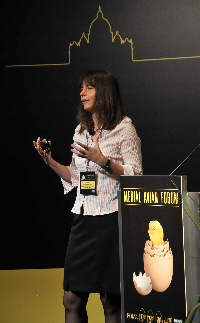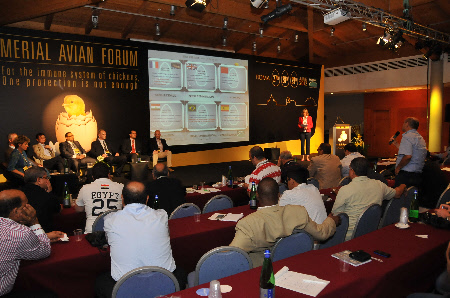



Avian Forum Pushes the Boundaries of Chicken Protection
Infectious bursal disease (IBD; also known as Gumboro disease) was the main focus of the Merial Avian Forum held recently in Rome. Senior editor, Jackie Linden, reports on the meeting.Organised by Merial, the event attracted experts and industry leaders from Europe, Middle East, North America, Latin America and Asia to share updates on avian immunosuppressive diseases and novel vector vaccine technology. More than 250 veterinarians and poultry production specialists from 36 countries in Europe, the Middle East, North and South America and Africa participated in the Merial Avian Forum in Italy’s capital city in June 2012.
Global Trends in Poultry Production
Changing global fundamentals in the markets for food and fuel demand and supply have put the global poultry industry at a crossroads where it will have to change, said Nan-Dirk Mulder of Rabobank International in his review about the prospects for the poultry industry in the future.
With feed costs accounting for between 50 and 70 per cent of the total production cost and no end in sight to the high and volatile prices of feed, he foresees a growth in poultry production in grain-producing regions such as the Americas and Black Sea, while Asia is forced to turn to imports of meat as the countries there struggle to match growing demand with supply of domestic products.
Examining the future of antimicrobials in poultry farming, Dr Dieter Schillinger, an animal health consultant based in Germany, stressed that access to safe and effective antibiotics is an essential component in every veterinarian’s toolbox and is a pre-requisite for treating sick animals, maintaining good health and preventing disease in others.
He stressed that the major factor affecting resistance development in humans worldwide has come from human antibiotic use, not from farm animals. The causes of recent focus on antibiotic use on farms resulted from the discovery of ESBL in broiler production and MRSA in on pig farms. Last year, the European Food Safety Authority (EFSA) recommended that the use of 3rd- and 4th-generation cephalosporins be discontinued in food-producing animals to stop the development and spread of bacterial resistance mechanisms.
Immune Function and Immunosuppression

Introducing the functioning of the chicken immune system, Professor Bernd Kaspers from the University of Munich in Germany convinced the audience how the various elements fit together in what he described as amazing teamwork.
New techniques have identified new growth factors that are involved in the maturation of B-cells, a development which is helping to bring better understanding of the interactions between the chicken host and the viruses causing Marek’s disease (MD) and Infectious Bursal disease (IBD).
The effects and detection methods for studying immunosuppression in chickens were described by Professor Silke Rautenschlein of the University of Veterinary Medicine in Hanover, Germany.
The detection of immunosuppressive conditions, such as MD and IBD, at the flock level is difficult under field conditions, she said, although some tools are already commercially available in some laboratories. She added that new strategies are needed to improve the detection of immunosuppressive conditions so that new methods of control can be developed.
Major Immunosuppressive Infections
IBD is an involving infection, inherently linked to the immune system, according to Dr Natàlia Majó Masferrer, assistant professor at the Universitat Autónoma de Barcelona in Spain. She explained that there are two serotypes of the virus, only one of which is pathogenic, and within that group, the families differ in pathogenicity and antigenicity. Both the classic and very virulent (vvIBDV) strains cause lesions in the bursa of Fabricius but the latter causes much higher mortality.
The vvIBDV strains were first isolated in Europe in 1987 and have since spread to Africa, Asia and South America. The first acute IBD outbreaks were reported in the Iberian Peninsula in the early 1990s, followed by a second wave in 2002. Dr Masferrer’s team has been monitoring the strains in field IBD cases ever since, concluding that vvIBDV has become endemic in the region.
Field cases of vvIBDV have declined markedly in recent years, she commented, attributing this to the growing use of new vaccine regimes (in-ovo vaccination) and to improved biosecurity measures implemented against Salmonella.
Dr Isabel Gimeno, Associate Professor at North Carolina State University in the US, described the Marek’s disease virus (MDV) as one that produces waves of infection against an army of immune cells in the chicken. MDV’s role in the development of lymphomas has been much studied, she said, but less so have the immunosuppressive effects, which appear to be more important in the recently emerging and more virulent types that seem to be more able to break vaccine immunity.
Recent work by Dr Gimeno’s team on this immunosuppressive form of MDV have shown that it can induce immunosuppression, even in the presence of maternal antibodies and in the absence of lymphoid organ atrophy. MD vaccines also differ in their ability to protect against MD, according to her research.
Global Experience with a Vector Vaccine: Beyond IBD And MD Protection
Merial Director and Leader of Avian Research and Development, Dr Nikki Pritchard, explained how VAXXITEK® HVT+IBD, a vector vaccine, has been developed for the control of IBD and MD worldwide. Its main feature, she said, is the single vaccination at the hatchery, which confers lifelong and broad protection against these two diseases, without compromising safety or efficacy.
Successful vaccination with the vaccine can be monitored by serological evaluation or by the use of qPCR, she added. In a trial on two farms, the birds at the farm that had received VAXXITEK HVT+IBD had higher antibody titres between about 25 and 45 days and 93 per cent protection against a vvIBD challenge than those using an intermediate MLV, where protection against the challenge was found in only six per cent of the birds.

There followed a roundtable discussion on field experience using VAXXITEK HVT+IBD across the world. The vaccine was launched in 2006 in Brazil and so far, 19 billion chickens across the globe have been vaccinated.
A field study in commercial layers to evaluate the effects of VAXXITEK HVT+IBD on growth, homogeneity and performance was described by Isabelle Devaud of Merial’s Avian Technical Service in France. Compared to the birds receiving an intermediate live vaccine, the VAXXITEK group had higher laying rate, average egg weight and shell breaking strength.
Neville Pennington, General Manager of Oaklands Farm Eggs in the UK outlined his experiences with the vaccine with layers. Comparing successive flocks without and then with VAXXITEK HVT+IBD, good and more even bodyweights have been achieved, overall bird health has improved and egg production is above the breed target.
From China, Hiu Wei Xi, Technical Director of the Lihua Group, described a trial comparing VAXXITEK HVT+IBD with the standard IBD programme on the performance of coloured chickens, which form an important sector of the local market in the country. At two of the company’s locations, chicks were split into two groups, one receiving the vector vaccine and the other received the standard modified live vaccine. At both sites, the VAXXITEC groups had numerically better performance, liveability and European Performance Index (EPI) and lower medication costs.
Also describing his work with the vaccine in broilers was Professor Ali Hussein Ahmed Hussein of Egypt’s Cairo University. On a farm with a history of IBD, Marek’s and respiratory infections, three consecutive broiler flocks were run with half the birds receiving VAXXITEK HVT+IBD and half with a live IBD vaccine. A small reduction in the number of slaughter days and improved feed conversion in the vector vaccine group raised the EPI by 10 points and reduced the production cost per kilo liveweight.
Animal Production Division Manager for COPACOL in Brazil, Irineu Dantes Peron, related his field experiences with VAXXITEK HVT+IBD in broilers in Paraná. In a very large field trial, 3.6 million broilers received the vector vaccine at the hatchery and the control group received one dose of HVT vaccine in ovo and two doses of live intermediate vaccine in the drinking water at seven and 14 days of age. The VAXXITEK group had lower mortality and feed conversion ratio, as well as higher daily weight gain and a five-point advantage in EPI.
The effects of VAXXITEK HVT+IBD on the production and quality parameters in broilers in Spain were covered by Dr Carlos Garcés of the University CEU Cardenal Herrera in Valencia. Broilers on 12 farms in the east of the country received the vector vaccine while those on the same number of farms were given an intermediate vaccine. There were significant improvements in feed conversion and slaughter age (at the same weight) for the VAXXITEK group, adding up to a 23-point improvement in EPI.
Interaction between the Immune System and IBD Vaccines in Chickens

Professor Rautenschlein returned to the stage to describe how different IBD vaccines interact with the immune system of broilers. Her team compared VAXXITEK HVT+IBD and a commercially available IBDV immune complex vaccine in terms of humoral and cell-mediated immunity in broilers. At 12 or 15 days post-hatch, the birds were inoculated with an inactivated Newcastle disease virus vaccine to determine possible immunosuppressive of the IBD vaccines on the development of antibodies to Newcastle disease.
The researchers observed that birds receiving the immune complex vaccine that had received the Newcastle disease vaccine at 15 days had lower antibody titres than the other groups. This is a significant finding as this is the age at which IBD-induced lesions start to develop and previous work has shown that even a transient depletion of B cells reduces the ability of birds to build up humoral immunity.
Merial’s Avian Technical Director for Europe, the Middle East and Africa, Dr Francesco Prandini, presented the results of a trial on layer pullets. The trial aimed to evaluate the effects of VAXXITEK HVT+IBD on the immune system, compared to two commercial modified live IBD vaccines. There was no depression in the number of circulating B cells at any of the time points in those pullets that had received the Merial vaccine; the other vaccines induced a significant reduction in B cells numbers during the 70-day trial period.
Making the Most of Modern Vaccines and Vaccination Programmes
The different types of vaccines and their development were described by Merial’s R&D Research Program Leader, Dr Michel Bublot. Early vaccines were of the ‘classical’ type, either inactivated on attenuated; biotech vaccines have been developed more recently, offering protection from two diseases at one time. The chicken is the farm species for which most biotech vaccines have been developed and products have been licensed using HVT, fowlpox (FP) and Newcastle disease virus as vectors against IBD, Newcastle disease, infectious laryngotracheitis, avian influenza and Mycoplasma gallisepticum.
HVT has some advantages over the other vector viruses and Dr Bublot attributed the success of VAXXITEK HVT+IBD, which is now used in more than 50 countries, to its superior safety and efficacy and a single hatchery administration. Against some diseases, the slower onset of immunity and absence of local immunity induction by vector vaccines are disadvantages although these are not issues for IBD.
The final presentation at the Avian Forum was on vaccination in the modern poultry industry, given by Dr Stéphane Lemiere, Global Director of technical services for avian medicines for Merial. He stressed the advantages of combining state-of-the-art vaccines and vaccination technology, particularly for hatchery vaccination. The controlled environment of the hatchery offers many advantages in terms of disease control in-ovo or in day-old chicks, not least in achieving the best possible protection of the birds early in life.
The current trend towards the development of more vector vaccines, especially those suitable for administration in ovo, are likely to continue in the future, according to Dr Lemiere, even if, as with Newcastle disease, full protection requires one or more applications of live vaccine later.
Further Reading
|
| - | Find out more information on the diseases mentioned in this article by clicking here. |
August 2012








